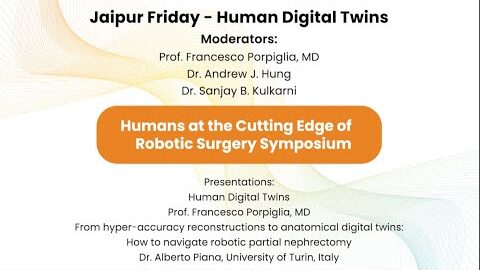2nd Place: #274- Dr. A. Ghazi: A Novel Patient-Specific Rehearsal Platform for Robot Assisted Partial Nephrectomy
This is the Second Place Winner of the 2023 KS International Innovation Awards videos as announced by the Vattikuti Foundation during the Humans at the Cutting Edge of Robotic Surgery Conference, October 6, 7 & 8, 2023 in Ghent, Belgium at the ORSI Academy.
From the entry:
Abstract: A Novel Patient-Specific Rehearsal Platform for Robot Assisted Partial Nephrectomy: Impact on Patient and Surgical outcomes Ahmed Ghazi MD, FEBU, MHPE Associate Professor of Urology and Oncology, Director of Minimal Invasive and Robotic Surgery, Director of Simulation Training Brady Urological Institute, Johns Hopkins University.
Introduction: With the advancement of surgical technology, the opportunity to integrate novel surgical preparation is imperative to improve patient outcomes and enhance safety, even for expert surgeons. Patient outcomes after completion of full procedural robot assisted partial nephrectomy (RAPN) simulations prior to complex cases were tracked for twenty subjects.
Methods: A combination of 3D printing and hydrogel injection molding were used to develop patient specific kidney phantoms for preoperative rehearsal of RAPN. The patient specific kidney phantoms are constructed starting with each patient’s scan, composed mainly of polyvinyl alcohol (PVA), and include the tumor, parenchyma, artery, vein, and calyx. To prove the accuracy of this process, the models are validated for anatomical accuracy, mechanical, and functional properties. The kidney phantom is then surrounded by the other hydrogel models of relevant anatomy and placed in a body cast replicating a patient, where a surgical rehearsal is completed in a simulated setting. First, the surgeon viewed the patient’s scan and answered a questionnaire regarding their surgical plan. Next, the simulation was completed and clinically relevant performance metrics of simulation, including ischemia time and estimated blood loss, and a secondary questionnaire about surgical planning was completed. In our first study, surgeons’ improvement in confidence ratings following review of standard imaging vs rehearsals was performed and simulation metrics were compared to live surgical metrics and changes in surgical plan after each rehearsal and were investigated. Secondly, 19 patients in which a rehearsal was completed prior to surgery were compared to a propensity matched group in which standard of care was performed. Operative and postoperative clinical metrics were compared.
Analysis and Results: Nineteen patients with complex renal masses (median RENAL nephrometry scores=10 and median tumor size=4cm) scheduled for RAPN were prospectively randomized for PO-PSS using either virtual planning or surgical rehearsals. They were propensity-matched 1:2 to a “control” group (n=38) in terms of pre-operative characteristics: Age, Nephrometry score, Tumor size, Body mass index (BMI), Charlson comorbidity index (CCI), American Society of Anesthesiology (ASA) score and pre-operative estimated glomerular filtration rate (eGFR). Outcome metrics included: Warm ischemia time (WIT), Entry into pelvi-calyceal system (e-PCS), Positive surgical margin (PSM), Conversion to radical nephrectomy, Clavien-Dindo (C-D) complications, Estimated blood loss (EBL), Transfusion, Length of hospital stay (LOS), and, changes in Hematocrit (Hct), Creatinine (Creat) and eGFR (eGFR). Both groups were evenly matched for all pre-operative variables (all p values greater than 0.05). In the Study group, Hct was significant (p=0.022) but did not translate to clinically significant differences in transfusion rates. C-D complications were less (p=0.024) overall with no major (C-D3) complications and this was reflected in a lower LOS (2 vs 4 days, p=0.007). One patient in the Control group required conversion to radical nephrectomy. There were also statistically significant differences in favor of the Study group with respect to a lower rate of e-PCS (p=0.046) and PSM (p=0.041). No significant differences were observed for WIT, EBL, Creat and eGFR between the groups.
Conclusion: Application of this versatile, inexpensive and reproducible method for creating kidney phantoms has resulted in authentic anatomical structures, physical properties and functional properties and increased confidence in surgical plan.
See more at: https://vattikutifoundation.com/videos/
Date
August 15, 2020






